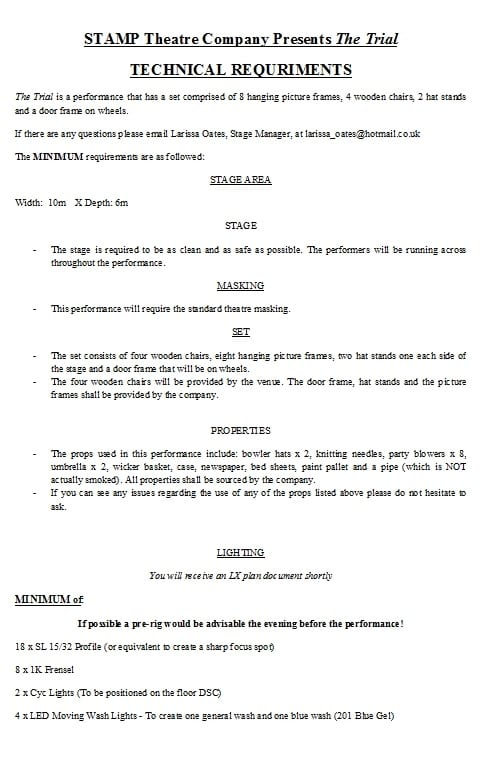From the perspective of a Stage Manager the performance day as a whole was a fantastic experience. As STAMP’s Technical Rider requested, the company were allowed into the theatre the evening before to pre-rig as well as set up the frames. In doing this the following day was made easier as the LPAC technicians only needed to focus the lights, which then allowed the company to go straight into a cue to cue run.
As the Stage Manager for this performance one of my main concerns on the day was to make sure all the props were in their correct position. Alex has mentioned in a previous post that our set included two hat stands positioned one on either side of the stage in which I placed the props on. I believed it was important to place the props in a way that would allow each performer to attain them as quickly and efficiently as possible.
After we had set up the stage the company was then able to do a complete run through of the play including the lights and the props. As this was the first time the company had done a run through on the stage with props and lights we were not expecting it to run smoothly, but we were all pleasantly surprised. I had made sure the company had rehearsed with props before the actual performance day, which enabled all the performers to be confident when collecting them from the stands. However, there were some slight changes in regards to the set. Taking advice from the LPAC Technicians, instead of using the black rope as well as the bungee cord for the frames we just used the bungee cord. This allowed the frames to be stretched in exactly the way we had wanted them to be. On the other hand due to the differing levels of the frames it made the back ones difficult to come to the front of the stage without the performer placing significant weight on them, as was the case in the ‘Bank Scene’. Lucy then suggested we act out this scene exactly how we had done during the rehearsals and not actually use the frames in that section. Although everyone seemed a bit unsure at first, during the run it worked perfectly and we carried it on into the final performance. Another useful thing we decided to carry on into the performance was marking the position of the chairs on stage. The chairs were constantly moved throughout the production but as we had specific spot lights on the frames it was important that all chairs were placed back in the correct positions under the spots. Having used tape during rehearsals to highlight chairs and frames I felt it would be a good idea to do the same for the actual performance. Doing this helped the actors find their places on stage quickly.
- Tech rehearsals
At the end of the performance I completed a show report to summaries how the production went:
Overall the day was a great success. The company had everything we needed to allow the performance and the day as a whole to run smoothly. With help from the LPAC Technicians the set and lights were set up swiftly allowing for the company to have significant rehearsal time on the stage. STAMP’s debut performance would not have been the success it was without the help of the LPAC staff.
Thanks for reading,
Larissa
xxx

























